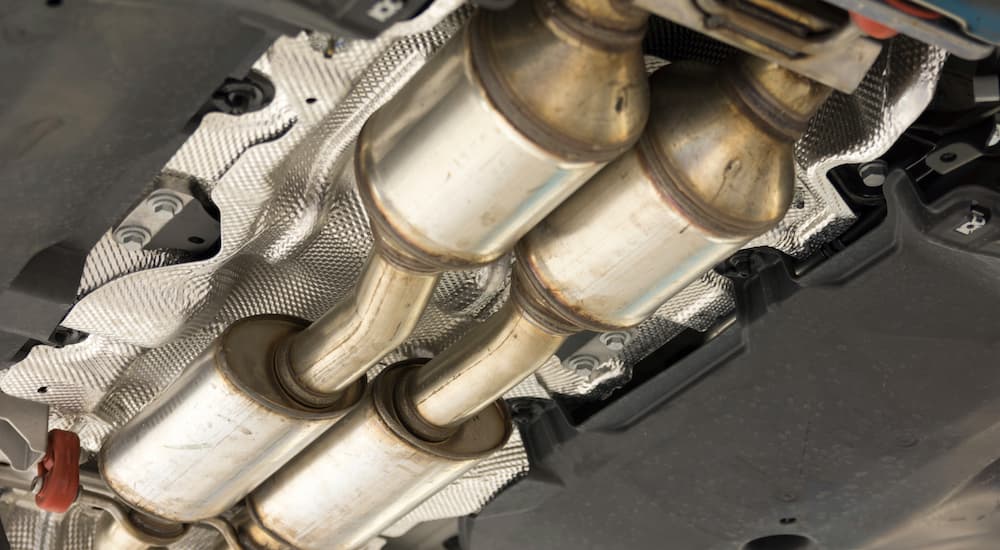The catalytic converter is the most important part of your car’s emissions control system. While it isn’t strictly necessary for your vehicle to function, it is critical for reducing harmful emissions. Most of the time, you will never need to think twice about it as catalytic converters are designed to last for the life of your vehicles; however, there are times when you may need to consider visiting an exhaust shop to get it checked. Like any mechanical component, a catalytic converter can fail or be damaged, and if it does, your car’s performance will be affected.
What Is a Catalytic Converter?
If you look at the exhaust system under your car, you will find three main components: the catalytic converter, resonator, and the muffler. The catalytic converter is always the one closest to the engine since it relies on the heat of the exhaust gasses to activate the catalysts. There are no moving parts inside the device. It uses a honeycomb structure made from ceramic, oxides, and precious metals, particularly platinum. These materials react to the exhaust gasses, turning toxic carbon monoxide and hydrocarbons into harmless carbon dioxide and oxidane (water).
Catalytic converters were first added to cars in the mid-1970s in response to the first emissions regulations. These early devices contributed to the end of the muscle car era because they restricted airflow from the engine and required the removal of lead from gasoline (lead increased octane ratings, but it is one of the chemicals that can “poison” a catalytic converter and damage it). However, modern catalytic converters have a negligible effect on performance. Modern exhaust systems are far better designed for good airflow, and computerized engine control units further optimize engine output.

What Can Go Wrong With a Catalytic Converter
Because a catalytic converter has no moving parts and is designed to last for the life of the vehicle, it will virtually never fail on its own. Every common type of failure is the result of either mechanical issues with other parts of the vehicle or outside damage to the exhaust system. This is good news because replacing a catalytic converter can be expensive. Because of the high cost of the precious metals inside it, a new catalytic converter will generally run between $1,000 and $2,000 before labor. In fact, one of the most common reasons to visit an exhaust shop for a new catalytic converter is because thieves stole your old one. That’s right. High metal prices have led to a surge in the number of catalytic converter thefts across the country.
Outside of thefts or damage from hitting road debris, most catalytic converter failures fall into two categories: clogging and overheating. Both of these issues are generally the result of engine problems, so if your catalytic converter stops functioning properly, make sure to find and solve the root cause of the problem before replacing the catalytic converter itself, or you’ll be back in the exhaust shop sooner or later. While it may be tempting to simply fix the obvious problem so you can pass emissions and not poison yourself with exhaust, as mentioned, buying new catalytic converters is not a cheap activity.
Also, be warned that a lot of what seem like catalytic converter problems may actually be caused by faulty sensors. The emissions control system in your vehicle relies on a number of sensors to finetune the air/fuel mixture being fed into the engine. These will include oxygen sensors on both ends of the catalytic converter and may have a collection of EGT (exhaust gas temperature) sensors, DPF (diesel particulate filter) sensors, and NOx sensors. If the wrong sensors fail, your car may behave as if there is an issue with the catalytic converter.
Catalytic Converter Contamination
The most common way to damage a catalytic converter is by contamination. Certain chemicals will damage the interior components, and many of those chemicals are used in the engine of your vehicle. In normal operation, the chemicals will not reach the catalytic converter in large enough quantities to cause any harm, but when things go wrong, your catalytic converter can become contaminated and stop working. Fortunately, preventing this is fairly simple––keep your engine maintained, and don’t drive with a check engine light on. If something goes wrong, fix it rather than let the problem continue.
The major chemicals to watch for are oil and coolant. If these chemicals are getting into your exhaust system, they will damage the catalytic converter, coating the catalyst and preventing it from doing its job. Sometimes these contaminants can be burned off, but whether it was the result of worn pistons or a leaking head gasket, this is the sort of issue that will have ramifications beyond just a failing catalytic converter.
Catalytic Converter Clogging
The other common form of contamination manifests itself a little differently. If unburned fuel enters the exhaust, it will ignite in the hot catalytic converter, producing soot. As soot accumulates, it will start to clog the exhaust, restricting airflow and strangling the engine, just like the early catalytic converters of the 1970s. The end result is reduced performance. Fortunately, simply keeping up with routine maintenance is usually enough to prevent this, as unburned fuel can be the result of simple issues like faulty sensors or worn spark plugs.
Catalytic Converter Overheating
Overheating isn’t good for any mechanical device, and catalytic converters are no exception. Get it hot enough, and the ceramic substrate inside will begin to melt and clog your exhaust. Overheating can actually be caused by fuel contamination, as unburned fuel igniting in the catalytic converter will produce excess heat. However, overheating can also simply be the result of pushing your engine too hard. Obviously, an overheated engine is already a problem that needs to be addressed immediately, but it can also damage your catalytic converter, racking up further repair bills at the exhaust shop.

Replacing a Catalytic Converter
While the price for a new catalytic converter can be high, replacing one isn’t actually a difficult task if you are comfortable working under your car. At its heart, the exhaust system is simply a collection of tubes bolted together, and it doesn’t necessarily require any special expertise or equipment to work on. The biggest issue that you will likely encounter is that catalytic converters generally only fail on older vehicles, so the exhaust system may be rusted together. Some manufacturers will also weld the exhaust components together, which will force you to cut out the old catalytic converter.
While you are replacing the catalytic converter, be careful of any exhaust sensors. Disconnect them before you begin work, and tuck them safely out of the way. Also, find a way to support the catalytic converter before you detach it to keep it from falling on you. When you connect the new catalytic converter, double-check that you are installing it in the right direction, and make sure that all the fittings are clean and sealed tightly to prevent dangerous exhaust leaks. Finally, check the sensors and exhaust hangers for damage––if they should be replaced, it’s easier to do it while you are already working on the car.
Emissions Are Important
While it may be tempting to simply remove a failing catalytic converter rather than spend the money to replace it, the emissions that it protects you from are not greenhouse gasses but toxic hydrocarbons and carbon monoxide. You will also not see any performance benefit from simply removing a catalytic converter, so keep the system working as intended. Plus, with a little basic car maintenance, you should never experience a catalytic converter failure or need to visit an exhaust shop to have it replaced, making this one of the most reliable parts of your car.

